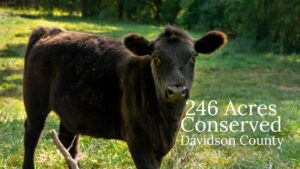
By Crystal Cockman
June 15, 2017

Back in early May on the day after our naturalist weekend, I was fortunate to get to join John Gerwin (ornithologist at the NC Museum of Natural Sciences), and his team of volunteers at a bird banding station in the Uwharries. This site is ideal for bird banding of a variety of species, as it has native warm season grasses, providing thick undergrowth, and edge habitat with hardwood forests nearby, and streams and the Uwharrie River are also close by. They set up mist-nets before I got there, and by the time I arrived nearly every volunteer had a bird in hand. Here is some more information about the species that were caught.

The bird that I was invited to take a picture was a yellow-breasted chat (Icteria virens). They are the largest of warblers. They breed in shrubby habitats in North America and travel to Central America for the winter. They are olive green with a bright yellow breast and a white eyering that connects to the bill, which makes them look like they have glasses on. They are shy birds that are often heard and not seen. They feed on berries and insects, including grasshoppers, beetles, bees, and moths. Their calls are full of whistles, cackles, clucks, and gurgles.
One of the birds caught in the mist-net was a common yellowthroat (Geothlypis trichas). Adult males have a bright yellow chest and a broad black mask, which females lack. They are one of the most numerous warblers. They are found frequently in fields and edges, and can be seen low to the ground in thickets, and prefer marshy habitats. They have a distinctive wichety-wichety-wichety call. There are 13 races of this bird, which differ in coloration. Northern races are nocturnal migrants, whereas southern races are largely resident.

Another bird we mist-netted was the Orchard Oriole (Icterus spurius). It is similar in appearance to the Baltimore Oriole, but trades in the bright orange chest for a deeper chestnut color. You’ll find them breeding in partially open areas with scattered deciduous trees. In breeding season they eat insects and spiders, while in the winter they eat more fruit and seeds. They are known to come to hummingbird feeders, or eat orange slices or jelly in backyards. Although they are the smallest of North America’s orioles, they are still larger than warblers and vireos.

There was one bird we second guessed our identification of but decided it was a veery (Catharus fuscescens). They are a cinnamon brown color with a white breast with spots on the throat. They are in the thrush family, and are medium sized among thrushes. They have a beautiful downward spiraling song. Like many of the other birds we caught, they were in a habitat they were well suited for, one with dense growth near a stream. Brown-headed cowbirds frequently parasitize their nests. They are similar in appearance to wood thrushes, swainson’s thrushes, and hermit thrushes.
All of these species require intact habitat to persist, and management that includes maintaining habitat diversity, protecting wetlands and riparian corrirdors, conserving mature hardwood forests and edge habitats, and controlling pollution are important to ensuring that these species are around for future generations.